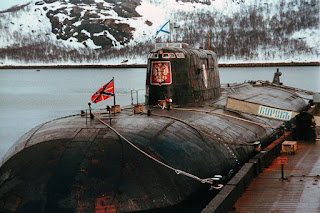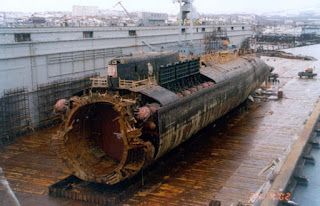The Kursk submarine disaster, the sinking of the nuclear-powered Oscar-class submarine Kursk, took place during the first major Russian naval exercise in more than ten years, in the Barents Sea on 12 August 2000, killing all 118 personnel on board. Nearby ships registered the initial explosion and a second, much larger, explosion which registered 4.2 on the Richter scale on seismographs as far away as Alaska, yet the Russian Navy did not realise that the sub had sunk and did not initiate a search for more than six hours. By the time it declared an emergency 11 hours later, the crew were—unknown to anyone—all dead. Because the sub's emergency rescue buoy had been intentionally disabled, it took more than 16 hours to locate the sunken boat.
Over four days, the Russian Navy failed to attach four different diving bells and submersibles to the escape hatch. The navy's response was criticized as slow and inept. The government misled and manipulated the public and news media, and refused help from other governments. President Vladimir Putin initially continued his vacation at a seaside resort, but on the fifth day authorized the navy to accept British and Norwegian offers of assistance. Seven days after the sinking, Norwegian divers finally opened a hatch to the escape trunk in the boat's flooded ninth compartment and found no survivors. The Russian government and navy came under intense criticism over the incident.
The official investigation, after most of the wreck was raised along with analysis of pieces of debris, concluded that the crew of Kursk was preparing to load a dummy 65–76 "Kit" torpedo when a faulty weld in its casing leaked high-test peroxide (HTP), causing the torpedo's kerosene fuel to explode. The explosion blew off the inner and outer tube doors, ignited a fire, destroyed the bulkhead between the first and second compartments, damaged the control room, and incapacitated or killed the control room crew. The torpedo manufacturer challenged this hypothesis, insisting that its design would prevent the kind of event described. Vice-Admiral Valery Ryazantsev drew attention to systemic faults in the Russian Navy, such as the risky use of highly volatile HTP torpedoes known to have caused the sinking of HMS Sidon. Ryazantsev accused the Russian navy of failing to properly train the crew, who did not appear to have properly closed the inner torpedo room safety door designed to protect the rest of the submarine. Eventually, the commission concluded that poor oversight, budget cuts, and incomplete maintenance inspections contributed to the explosion.
Two minutes and fifteen seconds after the initial blast, the Kursk submarine was on the bottom when the intense initial fire triggered the detonation of between five and seven torpedo warheads. The second explosion was equivalent to over 2 tonnes of TNT. It collapsed the bulkheads between the first three compartments and all the decks, tore a large hole in the hull, destroyed compartments four and five, and killed everyone still alive forward of the nuclear reactor in the fifth compartment. The nuclear reactors shut down safely. Following salvage operations, analysts concluded that 23 sailors in the sixth through ninth compartments took refuge in the small ninth compartment and survived for more than six hours. As oxygen ran low, crew members attempted to replace a potassium superoxide chemical oxygen cartridge, which accidentally fell into the oily sea water and exploded on contact. The resulting fire killed several crew members and triggered a flash fire that consumed the remaining oxygen, suffocating the remaining survivors. Lacking information, families of the victims engaged in an angry and volatile meeting with newly elected President Vladimir Putin. The video coverage of the meeting was sanitized for Russian audiences but leaked to international media, later shocking Russian audiences when they saw footage of a mother being forcibly sedated before she was removed from the meeting.
The following year, a Dutch team was contracted to raise the hull. Using newly developed lifting technologies, they recovered all but the bow, including the remains of 115 sailors, who were buried in Russia. More than two years after the sinking, the Russian government completed a 133-volume, top-secret investigation of the disaster. They released only a four-page summary through Rossiyskaya Gazeta, that revealed "stunning breaches of discipline, shoddy, obsolete and poorly maintained equipment", and "negligence, incompetence, and mismanagement". They concluded that the rescue operation was unjustifiably delayed and that the Russian Navy was completely unprepared to respond to the disaster. More details
Over four days, the Russian Navy failed to attach four different diving bells and submersibles to the escape hatch. The navy's response was criticized as slow and inept. The government misled and manipulated the public and news media, and refused help from other governments. President Vladimir Putin initially continued his vacation at a seaside resort, but on the fifth day authorized the navy to accept British and Norwegian offers of assistance. Seven days after the sinking, Norwegian divers finally opened a hatch to the escape trunk in the boat's flooded ninth compartment and found no survivors. The Russian government and navy came under intense criticism over the incident.
The official investigation, after most of the wreck was raised along with analysis of pieces of debris, concluded that the crew of Kursk was preparing to load a dummy 65–76 "Kit" torpedo when a faulty weld in its casing leaked high-test peroxide (HTP), causing the torpedo's kerosene fuel to explode. The explosion blew off the inner and outer tube doors, ignited a fire, destroyed the bulkhead between the first and second compartments, damaged the control room, and incapacitated or killed the control room crew. The torpedo manufacturer challenged this hypothesis, insisting that its design would prevent the kind of event described. Vice-Admiral Valery Ryazantsev drew attention to systemic faults in the Russian Navy, such as the risky use of highly volatile HTP torpedoes known to have caused the sinking of HMS Sidon. Ryazantsev accused the Russian navy of failing to properly train the crew, who did not appear to have properly closed the inner torpedo room safety door designed to protect the rest of the submarine. Eventually, the commission concluded that poor oversight, budget cuts, and incomplete maintenance inspections contributed to the explosion.
Two minutes and fifteen seconds after the initial blast, the Kursk submarine was on the bottom when the intense initial fire triggered the detonation of between five and seven torpedo warheads. The second explosion was equivalent to over 2 tonnes of TNT. It collapsed the bulkheads between the first three compartments and all the decks, tore a large hole in the hull, destroyed compartments four and five, and killed everyone still alive forward of the nuclear reactor in the fifth compartment. The nuclear reactors shut down safely. Following salvage operations, analysts concluded that 23 sailors in the sixth through ninth compartments took refuge in the small ninth compartment and survived for more than six hours. As oxygen ran low, crew members attempted to replace a potassium superoxide chemical oxygen cartridge, which accidentally fell into the oily sea water and exploded on contact. The resulting fire killed several crew members and triggered a flash fire that consumed the remaining oxygen, suffocating the remaining survivors. Lacking information, families of the victims engaged in an angry and volatile meeting with newly elected President Vladimir Putin. The video coverage of the meeting was sanitized for Russian audiences but leaked to international media, later shocking Russian audiences when they saw footage of a mother being forcibly sedated before she was removed from the meeting.
The following year, a Dutch team was contracted to raise the hull. Using newly developed lifting technologies, they recovered all but the bow, including the remains of 115 sailors, who were buried in Russia. More than two years after the sinking, the Russian government completed a 133-volume, top-secret investigation of the disaster. They released only a four-page summary through Rossiyskaya Gazeta, that revealed "stunning breaches of discipline, shoddy, obsolete and poorly maintained equipment", and "negligence, incompetence, and mismanagement". They concluded that the rescue operation was unjustifiably delayed and that the Russian Navy was completely unprepared to respond to the disaster. More details


No comments:
Post a Comment